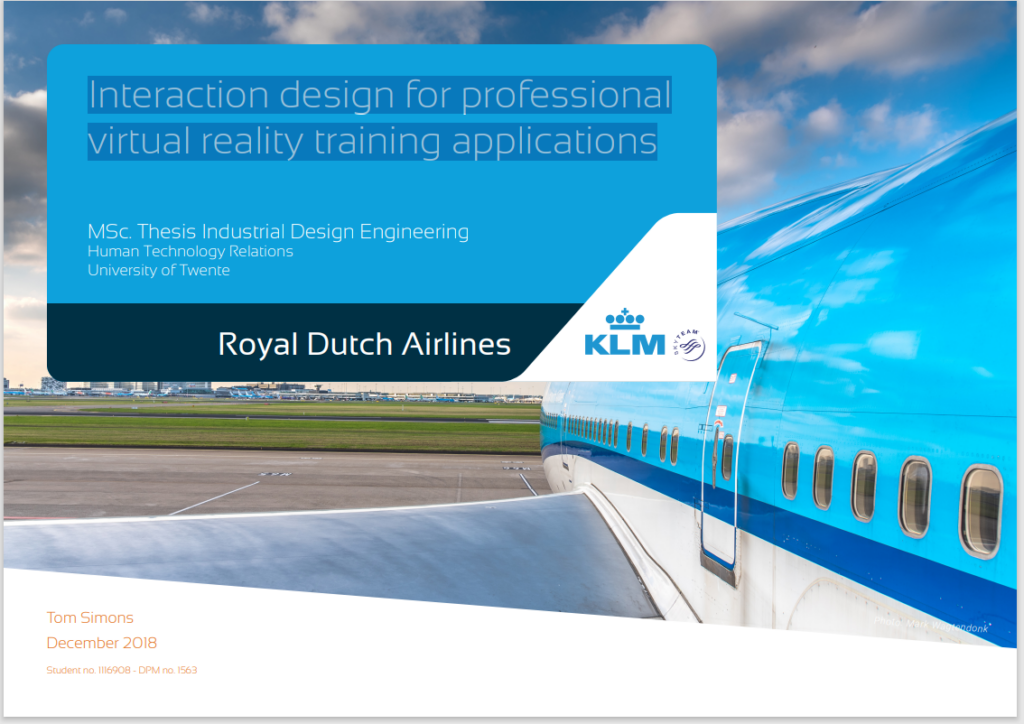Thesis Overview
Author: Tom Simons
Title: Interaction design for professional virtual reality training applications

The world of professional training is evolving, and Virtual Reality (VR) stands at the forefront of this transformation. In my exploration of good solutions that suits my thesis, I came across an intriguing master’s thesis by Tom Simons, which focuses on the application of VR in training KLM Royal Dutch Airlines’ cabin crew. This research not only shows the way for a more immersive training environment but also sets a benchmark for future training technologies.
Level of Design:
Simons’ thesis demonstrates a meticulous approach to interaction design, focusing on optimizing the user experience in a virtual environment. By developing a VR model specifically tailored for cabin crew training, Simons highlights the potential of VR to enhance learning outcomes through realistic, engaging scenarios that mirror actual in-flight challenges. For your UX in AR training, emphasizing user feedback loops and iterative design could be beneficial, particularly in adapting AR interfaces to user needs in real-time, enhancing learnability and usability.
Degree of Innovation:
The project stands out for its innovative use of VR technology to simulate training environments that are logistically challenging and costly to replicate in real life. Simons’ work introduces a shift from traditional methods to a virtual setup where trainees can practice and master their skills in a controlled, replicable, and safe environment, showcasing a significant leap in training technology.
Outline and Structure:
The thesis is well-structured, meticulously detailing each phase of the project from the initial orientation of VR within KLM to the final testing and future implications. This clear, logical structure not only aids in comprehending the complex technologies involved but also in appreciating the systematic approach taken to achieve the project goals.
Clarity in Communication
Simons excels in communicating complex ideas clearly and effectively, making extensive use of diagrams, prototypes, and real-world testing scenarios to ensure that the concepts are easily understandable. This level of clarity is crucial when dealing with advanced technologies like VR, where the ease of understanding can significantly impact the technology’s adoption.
Independence:
What impressed me about Simons‘ work is the level of independence in the execution of his project. From conceptualization to the final testing phase, Simons displayed profound initiative and leadership, guiding the project towards a successful implementation
Scope and Depth
The scope of Simons’ research is ambitious yet focused, addressing specific training needs within KLM and exploring the broad capabilities of VR in professional training. The project not only assesses the current state of VR training but also explores its future potential, providing a comprehensive overview of its application in professional settings.
Orthography and Accuracy:
With few typos or grammatical errors, the thesis exhibits a high degree of orthographic accuracy. Proofreading with attention to detail demonstrates a dedication to academic rigor. To guarantee the highest level of professionalism, a final review that concentrates on technical terminology and consistency in language use would be helpful.
Literature and Research Depth
Simons’ research is underpinned by an extensive review of relevant literature, providing a solid theoretical framework for the project. This robust foundation is crucial for validating the research outcomes and positioning the study within the wider context of VR technology advancements.
Tom Simons’ thesis not only contributes valuable insights into the use of VR in training but also inspires further research in this field. As I embark on my own journey to explore UX in AR training within the industrial sector, the lessons drawn from Simons’ research will undoubtedly influence my approach, encouraging a user-centric design and innovative application of emerging technologies.
I have learned about the tools in Virtual Reality. What is the biggest challenge for creating interaction for those technologies. Even if my topic is more on AR something different from VR; Those technologies are quite similar as they mostly involve immersion. Seingg Simon’s work gave me a hint on how o structure my own work and also know some use cases to refine my topic.